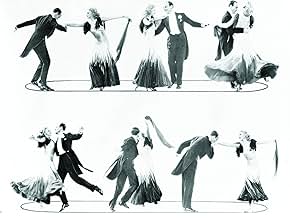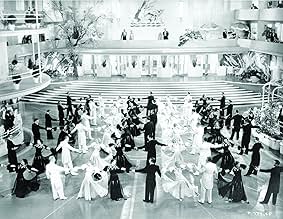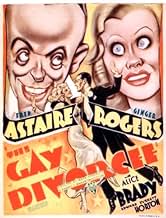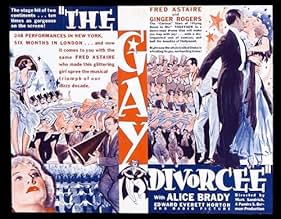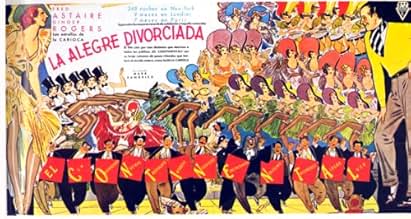IMDb-BEWERTUNG
7,3/10
9117
IHRE BEWERTUNG
Füge eine Handlung in deiner Sprache hinzuA woman thinks a flirting man is the co-respondent her lawyer has hired to expedite her divorce.A woman thinks a flirting man is the co-respondent her lawyer has hired to expedite her divorce.A woman thinks a flirting man is the co-respondent her lawyer has hired to expedite her divorce.
- 1 Oscar gewonnen
- 4 Gewinne & 5 Nominierungen insgesamt
Norman Ainsley
- Undetermined Role
- (Nicht genannt)
Jimmy Aubrey
- Undetermined Role
- (Nicht genannt)
Finis Barton
- Undetermined Role
- (Nicht genannt)
Eleanor Bayley
- Dancer
- (Nicht genannt)
De Don Blunier
- Chorus Girl
- (Nicht genannt)
Pokey Champion
- Dancer
- (Nicht genannt)
Jack Chefe
- Night Club Patron
- (Nicht genannt)
Empfohlene Bewertungen
Following an apparently accidental teaming in 1933's Flying Down to Rio (a fun Dolores Del Rio vehicle), Fred and Ginger got their first starring feature a year later. It was based on J. Hartley Manners' play 'The Gay Divorce'. The Hays Office insisted on shoving an 'e' on the end, for how could a divorce be so trifling as to be gay? Some UK prints still run with the original title. RKO assembled a sparkling ensemble cast of top-flight farceurs, bringing together (in ascending order of sublimity) Eric Blore, Edward Everett Horton and Erik Rhodes ("Are you a union man?"). Mark Sandrich directs the thing with a maximum of fuss and style. Hermes Pan helped Fred choreograph the numbers.
The plot is suitably - and delightfully - trivial. Musical star Guy Holden (Fred) happens upon a girl (Ginger), falls desperately in love with her, then spends the rest of the picture trying to free himself from marvellously silly plot threads and Everett Horton's exquisite quadruple-takes.
Keeping just one song from Cole Porter's original score, the timeless 'Night and Day', and adding only four others, The Gay Divorcée is more a comedy with songs than it is a musical comedy. But what comedy - and what songs! 'Looking For a Needle in a Haystack' is a masterpiece of economy: Fred a whirlwind of frustrated, lovestruck energy as he spins around his hotel room lamenting his missing love in peerless style. "Men don't pine," he memorably concludes, "Women pine. Men ... suffer." Everett Horton's rare excursion into song-and-dance territory is a breath of hysterical, liberating ludicrousness, as he knocks knees with a young Betty Grable. 'Don't Let It Bother You', performed by a chorus of dancing girls (and dolls), then spectacularly reprised by a tapping Astaire, is another treat. 'The Continental', the film's vast production number is peculiarly edited but sporadically fine and offers a fitting climax.
It's exceptional fluff, the sort of heady, heightened escapism that you don't come close to very often. An extravagantly mounted, joyous comedy played to perfection by two stars at their irresistible peak. Unmissable.
The plot is suitably - and delightfully - trivial. Musical star Guy Holden (Fred) happens upon a girl (Ginger), falls desperately in love with her, then spends the rest of the picture trying to free himself from marvellously silly plot threads and Everett Horton's exquisite quadruple-takes.
Keeping just one song from Cole Porter's original score, the timeless 'Night and Day', and adding only four others, The Gay Divorcée is more a comedy with songs than it is a musical comedy. But what comedy - and what songs! 'Looking For a Needle in a Haystack' is a masterpiece of economy: Fred a whirlwind of frustrated, lovestruck energy as he spins around his hotel room lamenting his missing love in peerless style. "Men don't pine," he memorably concludes, "Women pine. Men ... suffer." Everett Horton's rare excursion into song-and-dance territory is a breath of hysterical, liberating ludicrousness, as he knocks knees with a young Betty Grable. 'Don't Let It Bother You', performed by a chorus of dancing girls (and dolls), then spectacularly reprised by a tapping Astaire, is another treat. 'The Continental', the film's vast production number is peculiarly edited but sporadically fine and offers a fitting climax.
It's exceptional fluff, the sort of heady, heightened escapism that you don't come close to very often. An extravagantly mounted, joyous comedy played to perfection by two stars at their irresistible peak. Unmissable.
The superb Fred and Ginger series always ended with a big, big set piece where the two of them could dance, and 'The Gay Divorce(e)' is no exception. This time it is 'The Continental', which allows half of what passes for Brighton to join in the dance.
Not the most original of plots, this movie teamed the leads together for the second time (the first time they led the cast though). Both are terrific, and Fred's dancing throughout is a treat. Ginger is her usual bouncy self, all wisecracks and big eyes, and good on her feet. They're ably supported by Edward Everett Horton (as 'Aunt' Egbert), Alice Brady (the towering matriach, Rogers' aunt), Eric Blore (as an irritating waiter who likes talking about rocks and playing with words), Erik Rhodes (as a daft Italian), and Betty Grable (as a hotel guest who has a terrific number with Horton, 'Let's K-knock K-knees').
As you might guess, the story revolves around a divorce, which might be a gay one (in the 1930s definition of the word, of course), and, as so often in this series, mistaken identities. Tiny roles go to William Austin (as Rogers' blustering geologist hubby), and Lilian Miles (an Alice Faye lookalike who gets to reprise 'The Continental' all to herself).
This is one of the better entries in the series, ably directed by Mark Sandrich, and featuring a mix of songs including Cole Porter's 'Night and Day', and the jaunty 'Looking for a Needle in a Haystack'.
Not the most original of plots, this movie teamed the leads together for the second time (the first time they led the cast though). Both are terrific, and Fred's dancing throughout is a treat. Ginger is her usual bouncy self, all wisecracks and big eyes, and good on her feet. They're ably supported by Edward Everett Horton (as 'Aunt' Egbert), Alice Brady (the towering matriach, Rogers' aunt), Eric Blore (as an irritating waiter who likes talking about rocks and playing with words), Erik Rhodes (as a daft Italian), and Betty Grable (as a hotel guest who has a terrific number with Horton, 'Let's K-knock K-knees').
As you might guess, the story revolves around a divorce, which might be a gay one (in the 1930s definition of the word, of course), and, as so often in this series, mistaken identities. Tiny roles go to William Austin (as Rogers' blustering geologist hubby), and Lilian Miles (an Alice Faye lookalike who gets to reprise 'The Continental' all to herself).
This is one of the better entries in the series, ably directed by Mark Sandrich, and featuring a mix of songs including Cole Porter's 'Night and Day', and the jaunty 'Looking for a Needle in a Haystack'.
Fred and Ginger, two perfect partners, two of the best dancers in history. In 1934, the toast of RKO. What a great pair the studio that would become defunct in a matter of years had on their hands!
In 1933, the pair had proven themselves as second leads in "Flying Down to Rio", a musical heavily relying on special effects and little else. They stole the show, proven with "The Carioca", the erotically charged dance number which started an American craze of pressing foreheads and even got the Best Song Oscar nod over the supposed show stopping title song. Before, Ginger had "42nd Street" to her name, while Fred had the famous screen test analysis of "Can't sing. Can't act. Can dance a little."
"The Gay Divorcee" is the establishing musical of Astaire and Rogers. Silly, dated, slight, even stupid to a certain degree is the entire story. Without a doubt, high comedy and immense creativity make up for it. The mistaken identity plot was recycled for "Top Hat" the following year, but it hardly matters. It is littered entirely with hilarity! Writing was never the strongest point of these musicals anyway. The performances were not Oscar calibre but they were publicly loved, and it's obviously Astaire and Roger's singing, acting and most of all, dancing, that makes the movie what it is.
A top wealth of talent was assembled for the movie. Erik Rhodes is absolutely side splitting as the Italian guy Tonetti, wielding the fabulous line, "Your wife is safe with Tonetti, he prefers spaghetti!". Alice Brady is there as Aunt Hortense, but Edward Everett Horton is another stand out performer as the lawyer. His fumbling voice provides a character of clumsiness and two seem to go hand in hand. He was definitely one of the best supporting comedians of the 1930s and 1940s, in other Astaire and Rogers musicals, and movies like "Lost Horizon", "Holiday", "Here Comes Mr Jordan" and "Arsenic and Old Lace".
Only one song was retained for the filmic version of "The Gay Divorcee". The censors even crashed down on the stage's original title "The Gay Divorce". Fred performs a great rendition of the immortal Cole Porter song "Night and Day". "The Continental", the Best Song of 1934 is thrown there in the mix too. Other great numbers in there include "Looking for a needle in a haystack", "Don't Let it Bother You" and "Let's K-nock- K-nees". The latter is performed by a young Betty Grable. This is notable for the only time Edward Everett Horton sings and dances on screen. We can see from the results there's an obvious reason.
The stylish period of courtship and even set decoration and costumes evoke great memories of eras gone by. RKO hasn't helped preservation of these technical elements by throwing what always appears to be mediocre sets, but it doesn't matter anyway. The whole thing is irresistible, spectacular and unforgettable. This is one of the forgotten musicals of the time which has it all.
Rating: 8/10
In 1933, the pair had proven themselves as second leads in "Flying Down to Rio", a musical heavily relying on special effects and little else. They stole the show, proven with "The Carioca", the erotically charged dance number which started an American craze of pressing foreheads and even got the Best Song Oscar nod over the supposed show stopping title song. Before, Ginger had "42nd Street" to her name, while Fred had the famous screen test analysis of "Can't sing. Can't act. Can dance a little."
"The Gay Divorcee" is the establishing musical of Astaire and Rogers. Silly, dated, slight, even stupid to a certain degree is the entire story. Without a doubt, high comedy and immense creativity make up for it. The mistaken identity plot was recycled for "Top Hat" the following year, but it hardly matters. It is littered entirely with hilarity! Writing was never the strongest point of these musicals anyway. The performances were not Oscar calibre but they were publicly loved, and it's obviously Astaire and Roger's singing, acting and most of all, dancing, that makes the movie what it is.
A top wealth of talent was assembled for the movie. Erik Rhodes is absolutely side splitting as the Italian guy Tonetti, wielding the fabulous line, "Your wife is safe with Tonetti, he prefers spaghetti!". Alice Brady is there as Aunt Hortense, but Edward Everett Horton is another stand out performer as the lawyer. His fumbling voice provides a character of clumsiness and two seem to go hand in hand. He was definitely one of the best supporting comedians of the 1930s and 1940s, in other Astaire and Rogers musicals, and movies like "Lost Horizon", "Holiday", "Here Comes Mr Jordan" and "Arsenic and Old Lace".
Only one song was retained for the filmic version of "The Gay Divorcee". The censors even crashed down on the stage's original title "The Gay Divorce". Fred performs a great rendition of the immortal Cole Porter song "Night and Day". "The Continental", the Best Song of 1934 is thrown there in the mix too. Other great numbers in there include "Looking for a needle in a haystack", "Don't Let it Bother You" and "Let's K-nock- K-nees". The latter is performed by a young Betty Grable. This is notable for the only time Edward Everett Horton sings and dances on screen. We can see from the results there's an obvious reason.
The stylish period of courtship and even set decoration and costumes evoke great memories of eras gone by. RKO hasn't helped preservation of these technical elements by throwing what always appears to be mediocre sets, but it doesn't matter anyway. The whole thing is irresistible, spectacular and unforgettable. This is one of the forgotten musicals of the time which has it all.
Rating: 8/10
After their hit dancing of the "Carioca" in "Flying Down the Rio," RKO gave the teaming of Fred Astaire and Ginger Rogers a star role in "The Gay Divorcée" in 1934.
With few exceptions, the plots of the Fred-Ginger films were excuses to get to the important part - the dancing - but the story lines were always pleasant and the casting good.
"The Gay Divorcée" was based on a Broadway musical (of which the only number retained is "Night and Day") and it appears that a few of its plot devices were adopted in later Astaire-Rogers films as well.
One such plot device is that of mistaken identity. In this movie, Astaire (reprising his Broadway role) is mistaken for a professional correspondent hired to help Rogers get her divorce. Another device is that at first, Ginger is never interested in Fred - that goes here, too.
And there's a stock cast in these films, namely, Edward Everett Horton and Eric Blore (and of course, he's always the butler and always very funny). Horton plays Rogers' attorney whose major problem is Rogers' aunt (Alice Brady).
What can be said about the dancing except that it's glorious? Fred and Ginger dance to "Night and Day" after Astaire sings it to her. For a supposed non-singer, Astaire could really put over a song - his voice is pleasant and he's so musical - no wonder composers wrote songs for him.
Ginger is beautiful and spunky as Mimi, a young woman ducking Fred while she's trying to get a divorce. Betty Grable has a bit that showcases her in the number "Let's K-knock Kneez." There's also "I'm Looking for a Needle in a Haystack" delightfully sung and danced by Fred. Astaire's dancing is fantastic throughout.
It feels as if about half the picture is taken up with the elaborately staged production number, "The Continental." In later films, of course, the dancing would center more around Fred and Ginger, but it's a great part of the movie and certainly solidified these two as a top box office pairing.
For pure enjoyment, there's nothing like watching Astaire & Rogers in these movies.
With few exceptions, the plots of the Fred-Ginger films were excuses to get to the important part - the dancing - but the story lines were always pleasant and the casting good.
"The Gay Divorcée" was based on a Broadway musical (of which the only number retained is "Night and Day") and it appears that a few of its plot devices were adopted in later Astaire-Rogers films as well.
One such plot device is that of mistaken identity. In this movie, Astaire (reprising his Broadway role) is mistaken for a professional correspondent hired to help Rogers get her divorce. Another device is that at first, Ginger is never interested in Fred - that goes here, too.
And there's a stock cast in these films, namely, Edward Everett Horton and Eric Blore (and of course, he's always the butler and always very funny). Horton plays Rogers' attorney whose major problem is Rogers' aunt (Alice Brady).
What can be said about the dancing except that it's glorious? Fred and Ginger dance to "Night and Day" after Astaire sings it to her. For a supposed non-singer, Astaire could really put over a song - his voice is pleasant and he's so musical - no wonder composers wrote songs for him.
Ginger is beautiful and spunky as Mimi, a young woman ducking Fred while she's trying to get a divorce. Betty Grable has a bit that showcases her in the number "Let's K-knock Kneez." There's also "I'm Looking for a Needle in a Haystack" delightfully sung and danced by Fred. Astaire's dancing is fantastic throughout.
It feels as if about half the picture is taken up with the elaborately staged production number, "The Continental." In later films, of course, the dancing would center more around Fred and Ginger, but it's a great part of the movie and certainly solidified these two as a top box office pairing.
For pure enjoyment, there's nothing like watching Astaire & Rogers in these movies.
Quoting the Eric Blore/Alice Brady interchange in the restaurant, this movie is indeed whimsical (or "whumsical") and beautiful to boot. There probably has never been a more perfect dance than "Night and Day"....or a more beautiful song to dance to. That is the highlight of this film, although the rest of it is well worth seeing. Erik Rhodes is absolutely hilarious as the paid correspondent and the humor is not dated which is unusual in a film of this age. The "Chance is a fool's name for fate" routine is priceless. Edward Everett Horton again proves that he is the originator of the befuddled sidekick without being irritating and his little "dance" with a very young Betty Grable is such fun The art deco sets and great 30's clothes are wonderful and it makes you wish for a time when everybody wore evening dress and danced at the drop of a hat. Don't miss it...this is one of the highlight Astaire/Rogers efforts.
Wusstest du schon
- WissenswertesThe musical number "The Continental" lasts 17 1/2 minutes, the longest number ever in a musical until Gene Kelly's 18 1/2-minute ballet at the end of Ein Amerikaner in Paris (1951) 17 years later. It is also the longest musical number in all of Fred Astaire and Ginger Rogers' films together.
- PatzerDuring the car chase, Guy makes a quick turn on a dirt road, and a sound effect of squealing tires is heard. Tires do not make a squealing noise on dirt.
- Zitate
Tonetti: [unable to remember his passphrase "Chance is a fool's name for fate," Tonettie repeatedly muffs it] Chance is the foolish name for fate. / Give me a name for chance and I am a fool. / Fate is a foolish thing to take chances with. / I am a fate to take foolish chances with. / Chances are that fate is foolish. / Fate is the foolish thing. Take a chance.
- Alternative VersionenIn the version of the movie released in Brazil in the 1930s, the Brazilian actor Raul Roulien sang in the musical number "The Continental".
- VerbindungenEdited into Joan of Paris (1942)
- SoundtracksDon't Let It Bother You
(1934)
Music and Lyrics by Mack Gordon and Harry Revel
Dance performed by Fred Astaire
Top-Auswahl
Melde dich zum Bewerten an und greife auf die Watchlist für personalisierte Empfehlungen zu.
- How long is The Gay Divorcee?Powered by Alexa
Details
- Erscheinungsdatum
- Herkunftsland
- Offizieller Standort
- Sprachen
- Auch bekannt als
- La alegre divorciada
- Drehorte
- Santa Monica, Kalifornien, USA(Exterior)
- Produktionsfirma
- Weitere beteiligte Unternehmen bei IMDbPro anzeigen
Box Office
- Budget
- 520.000 $ (geschätzt)
- Weltweiter Bruttoertrag
- 6.879 $
- Laufzeit1 Stunde 47 Minuten
- Farbe
- Seitenverhältnis
- 1.37 : 1
Zu dieser Seite beitragen
Bearbeitung vorschlagen oder fehlenden Inhalt hinzufügen



